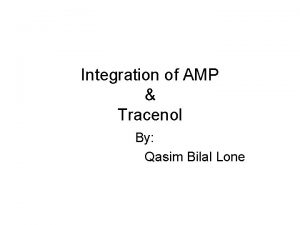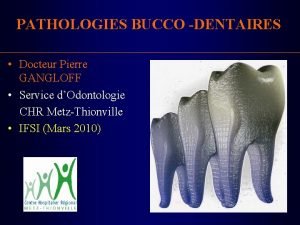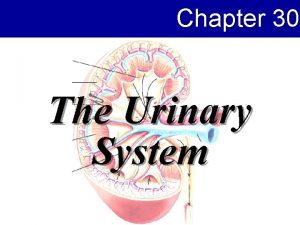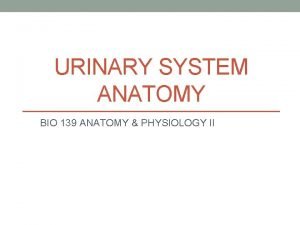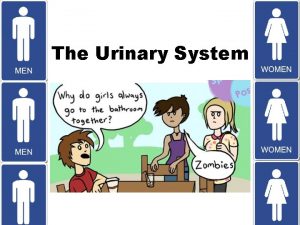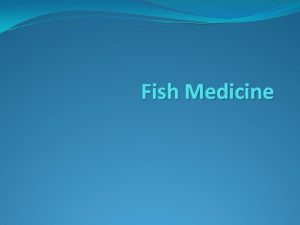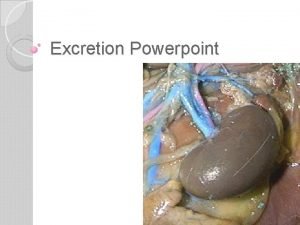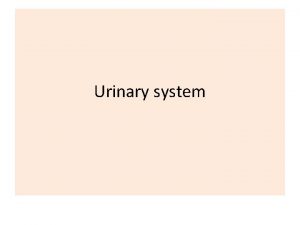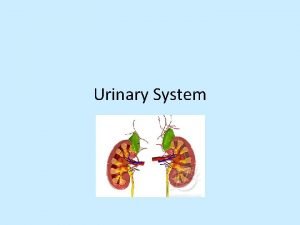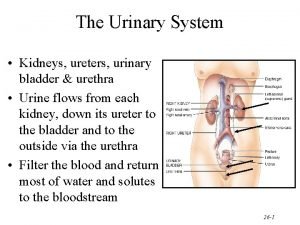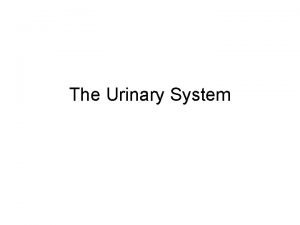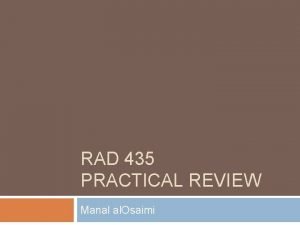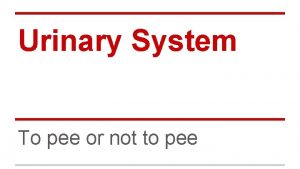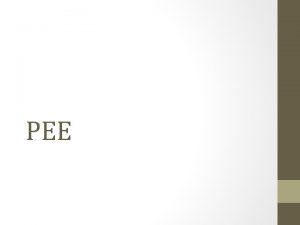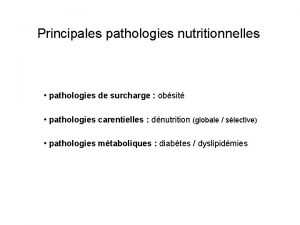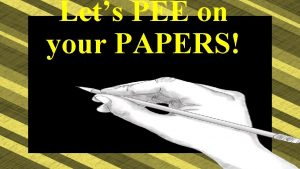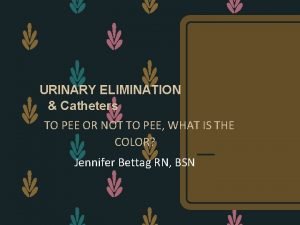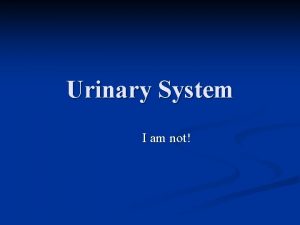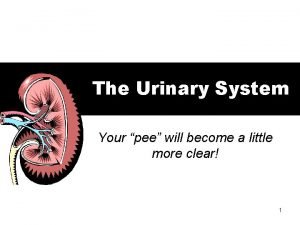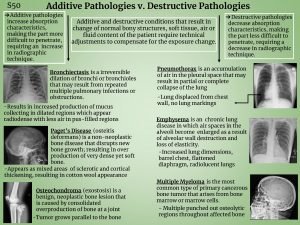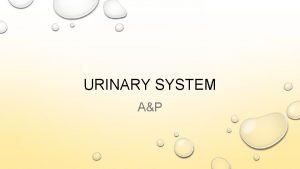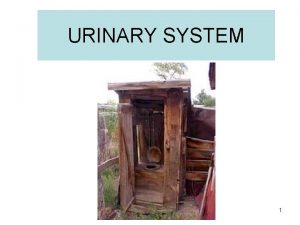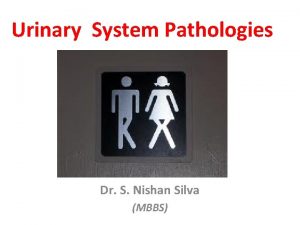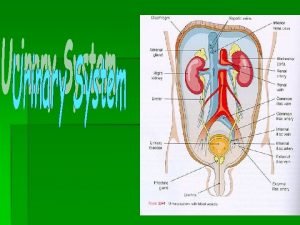Urinary System Pathologies To pee or not to




















- Slides: 20

Urinary System Pathologies To pee or not to pee

Organs of the urinary system l l 2 kidneys 2 ureters 1 urinary bladder 1 urethra

Responsibilities l l l Producing Storing Excreting urine Cleansing waste product left from metabolism from the blood Regulation water, salts and acids to insure homeostasis of acid-base balance Part of regulating BP, ADH/vasopressin

Normal Function of the System l l The Nephron: working unit responsible for filtration, reabsorption and secretion of urine. Each Kidney is made up of 1 million nephrons.

Other functions of the kidneys l l l Secretes the hormone renin that raises BP Produces erythropoietin that stimulates production of rbcs. Plays a role in activation of Vitamin D

Trauma, Toxins, and Scarring l Can all result in damage to renal function that may allow urea (nitrogenous waste of metabolism) or extracellular fluid and electrolytes to accumulate in the blood.

Other disorders: l l l Obstructions: tumors, structural defects that may be acquired or congenital. Immunologic disorders Circulatory problems Cystic disease Metabolic disorders l All can cause the system to be compromised

Common abnormal symptoms l l l l l Loss of appetite Fever Nausea HA/body aches Flank pain Low back pain Hematuria Edema pruritus l l Decrease in urine output Increase in BP

l l l Usually symptoms reflect an accumulation of waste products in the blood causing electrolyte imbalances in the body. Often the first diagnostic test to be done is the urinalysis: physical, chemical and microscopic examination of the urine What is meant by physical, chemical and micro exam of urine: describe.

Urinalysis: l l l Demonstrates the filtration, absorption and elimination of metabolic waste and precise fluid and electrolyte balance Other tests may include C & S, radiologic tests and view structural problems and cystoscopy or even biopsy of lesions. SEE PAGE 504 OF TEXT: ROUTINE URINALYSIS

l See page 505: renal diagnostic tests

Urine Terminology l l l Incontinence: loss of voluntary control or the bladder Retention: inability to empty the bladder, may be accompanied by overflow incontinence. Micturation (urination or voiding) reflex is stimulated by increased pressure within the urinary bladder as it distends (fills) the reflex is sent to • Parasympathetic nerves and they send impulse to the sphincters of the bladder and the pelvic diaphragm (muscles) to relax and the bladder muscles contract emptying the bladder

Causes of Incontinence l l l Increased intra-abdominal pressure: laughing/coughing Multiple pregnancyies with vaginal delivery Age Spinal cord injuries Or brain damage in control areas

Common blood tests l l BUN: blood, urea, nitrogen and serum creatinine: indicate failure to excrete nitrous waste from protein metabolism. GFR Metabolic acidosis (decreased serum p. H and decreased serum bicarbonate: indicated decrease GFR, and failure of the tubules to control acid-base balance

Common blood tests: cont. l l Anemia: low hbg level: indicated decreased erythropoietin secretion and/or bone marrow depression, due to accumulation of wastes. Electrolytes: depend on related fluid balance: specific to retention of fluid if GFR is decreased may result in a dilution effect, and lab values are not a true reflection of renal status. However may still require monitoring and treatment.

Common blood tests: cont. l l l Antibody level: antistreptolysis O (ASO) or antitreptokinase (ASK) titers are used for diagnosis of post-streptococcal glomerulonephritis. Renin levels: indicate possible cause of hypertension. C & S: used to ID causative organism of infection if present and best antibiotic

Common blood tests: cont. l l l 24 -hour urines like creatinine or insulin clearance or radioisotope studies are used to access GFR. Radiologic tests: IVP, angiography, ultrasound, Ct, MRI, radionuclide imagine all may be used to visualize structures and any abnormalities of the Urinary system Cystoscopy: visualized the Lower UT and may be used in performing a biopsy or removing kidney stones.

l l l l What is the normal p. H of blood and urine? Urine: 6. 0 is this acid or base Acidic Blood: 7. 35 -7. 45 is this acid or base Slightly basic

See text bos 11 -1 pg 511 l Nephrotoxic agents:

MORE TERMINOLOGY l l l l Ren/o Olig/o Nephr/o Pyel/o Hydr/o Calculi Lith/o Cyst/o l l l l Nocturia Polyuria Azotemia KUB IVP Cystourethrography Voiding (VCUG)
 Pathologies
Pathologies Pathologies
Pathologies Spleen function
Spleen function Not genuine, not true, not valid
Not genuine, not true, not valid Urinary system introduction
Urinary system introduction Chapter 15 urinary system
Chapter 15 urinary system Scanty urination medical terminology
Scanty urination medical terminology Intugementary
Intugementary Male fetal pig reproductive system labeled
Male fetal pig reproductive system labeled Chapter 30 the urinary system workbook answers
Chapter 30 the urinary system workbook answers Kidney pyramid labeled
Kidney pyramid labeled Chapter 20 urinary/excretory system
Chapter 20 urinary/excretory system Urinary system model
Urinary system model Urinary system fun fact
Urinary system fun fact Placoid scales definition
Placoid scales definition Urinary system powerpoint
Urinary system powerpoint Renal system
Renal system Adh function
Adh function Renal corpuscle
Renal corpuscle Abnormal constituents of urine
Abnormal constituents of urine Urinary system x ray labeled
Urinary system x ray labeled
